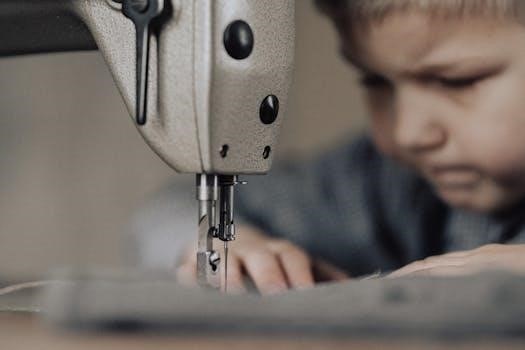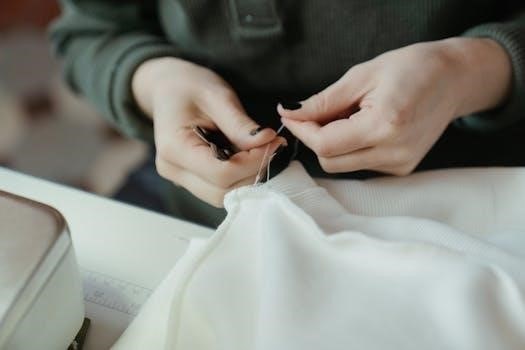Singer One Sewing Machine Manual⁚ An Overview
The Singer One sewing machine manual serves as a vital resource for users, providing detailed instructions on operation, maintenance, and troubleshooting. This document, available in PDF format, covers all aspects of the machine, ensuring smooth and efficient sewing experiences. Accessing this guide is essential for optimal performance.
The Singer One is a popular sewing machine known for its user-friendly design and versatility, catering to both beginners and experienced sewers. This machine is part of Singer’s long history of producing quality sewing equipment, now under SVP Worldwide. The Singer One combines modern features with traditional functionality, making it a reliable choice for various sewing projects. Its design focuses on ease of use, with clear controls and an intuitive interface. The availability of comprehensive instruction manuals further supports users in maximizing their machine’s potential. Whether you’re working on simple alterations or complex creations, the Singer One aims to provide a seamless sewing experience. Understanding its features and operation through the manual is crucial to harnessing its full capabilities. The model has earned positive user ratings, highlighting its dependability and user-friendliness. The Singer One stands out as a testament to Singer’s dedication to sewing innovation and quality.
Locating and Downloading the Manual
Finding the Singer One sewing machine manual is straightforward, as it is typically available in digital PDF format. Users can often locate the manual on the official Singer website or through authorized online retailers. These manuals are usually free to download, providing easy access to essential information. Additionally, various online forums and sewing communities may also host copies of the manual, allowing for alternative download locations. When searching online, it is crucial to ensure you are downloading from a reputable source to avoid malware or incorrect versions. The manual should be specific to the Singer One model to ensure accurate guidance. Once downloaded, the PDF manual can be viewed on a computer, tablet, or smartphone, providing convenient access while operating the machine. Having a digital copy allows for quick referencing of specific instructions and troubleshooting steps. This ensures users can readily resolve any issues or clarify procedures, enhancing their sewing experience.

Understanding Your Singer One Machine
Grasping your Singer One’s features is crucial for effective use. Familiarity with components and operation ensures smooth sewing. The manual provides a comprehensive guide, detailing each part’s function and how they work together to produce quality stitches.
Key Components and Features
The Singer One sewing machine boasts several key components, each playing a vital role in its operation. The needle plate, often a replaceable part, ensures smooth fabric feed and precise stitch formation. The bobbin case, another critical element, holds the bobbin and regulates thread tension. The spool pin supports the thread spool, allowing for consistent thread delivery to the needle. These components, along with others like the feed dogs and presser foot, are essential for sewing. The manual provides detailed diagrams and explanations of each component’s function. Understanding these features not only aids in proper use but also helps in identifying and resolving issues that may arise during sewing. The machine’s design incorporates these elements for both functionality and user ease.
Basic Operation Guide
The Singer One’s basic operation begins with properly threading the machine, a process detailed step-by-step in the manual. This involves guiding the thread through various tension discs and guides before reaching the needle. Correct bobbin winding and insertion are also crucial first steps. The manual emphasizes ensuring the bobbin is wound evenly and placed correctly within the bobbin case. Once threaded, the user should select the desired stitch pattern and adjust the stitch length, if necessary. The sewing process itself requires guiding the fabric gently, avoiding any pulling or pushing that could deflect the needle. The machine’s controls are user-friendly, allowing for easy speed adjustment and start/stop functions. Following these basic operational guidelines from the manual will ensure successful and enjoyable sewing projects. It is also important to power the machine with the switch on the side.

Troubleshooting Common Issues
The Singer One manual addresses common problems like bobbin issues, including winding and tension, and needle breakage. It also provides guidance on machine cleaning to prevent malfunctions. These troubleshooting tips ensure smooth operation.
Bobbin and Thread Problems
Bobbin and thread issues are among the most frequent challenges encountered while using a sewing machine, and the Singer One is no exception. The manual provides detailed instructions to address these problems effectively. A common issue is incorrect bobbin winding, which can lead to uneven stitches or thread jams. The manual explains how to wind the bobbin correctly, ensuring the thread is evenly distributed. Proper bobbin insertion into the bobbin case is also critical; the guide illustrates the correct positioning to prevent thread snags. Another significant area is bobbin tension adjustment. The manual offers instructions on how to adjust the tension, ensuring smooth and consistent stitch quality. Lastly, ensure the bobbin is wound evenly and correctly placed in the case. These steps are critical for optimal machine function.
Incorrect Bobbin Winding
Incorrect bobbin winding is a common culprit behind sewing machine issues, especially with the Singer One. When the bobbin is not wound properly, it can lead to a host of problems such as uneven stitches, thread breakage, and jamming of the machine. The manual emphasizes the importance of winding the bobbin evenly, ensuring the thread lays flat and doesn’t overlap excessively. To avoid this, the guide provides step-by-step instructions, often including diagrams, on how to correctly position the thread and operate the bobbin winder mechanism. It also cautions against overfilling the bobbin, which can hinder its smooth rotation within the bobbin case. The instructions may also highlight using the correct type of thread and bobbin for the Singer One. Proper winding technique is crucial for optimal sewing performance. By following the manual’s guidelines, users can minimize the risks associated with improperly wound bobbins.
Bobbin Tension Adjustment
Proper bobbin tension is crucial for achieving balanced and consistent stitches with your Singer One sewing machine. The manual provides detailed guidance on how to adjust the bobbin tension, a process that is essential when experiencing issues like loops on the underside of the fabric or overly tight stitches. The adjustment process involves carefully manipulating a small screw on the bobbin case, a task that requires patience and precision. The manual will typically advise making very small incremental adjustments, testing the stitches after each change to assess the impact. It will also offer visual cues and examples of correctly balanced tension. Often, the manual will warn against over-adjusting this screw, as it could cause damage or further problems. Understanding how to fine-tune the bobbin tension according to the fabric and thread being used is critical for successful sewing. By referencing the manual, users can learn to identify and correct tension issues, leading to more professional and reliable results.
Needle Breakage and Deflection
Needle breakage and deflection are common issues that users of the Singer One sewing machine might encounter. The manual addresses these problems by highlighting several possible causes. One frequent cause is pulling or pushing the fabric while stitching; this can deflect the needle, leading it to bend or break. The manual strongly advises against forcing the fabric through the machine, emphasizing instead the need to let the feed dogs move the fabric naturally. Another cause is using the wrong type or size of needle for the fabric being sewn. The manual will provide guidance on needle selection, indicating which sizes and types are appropriate for different materials. Improper threading or incorrect needle insertion can also cause these issues. The guide will detail the correct way to thread the machine and insert the needle. Furthermore, the manual often advises users to wear safety glasses to protect their eyes from potential injury if a needle breaks. Proper maintenance and careful operation, as outlined in the manual, can significantly reduce needle breakage and deflection.
Machine Cleaning and Maintenance
Regular cleaning and maintenance are crucial for ensuring the longevity and optimal performance of your Singer One sewing machine, as detailed in the manual. The accumulation of dust and lint in the machine can lead to various issues, including decreased stitch quality and potential mechanical problems. The manual will typically instruct users on how to clean the feed dogs, bobbin area, and the area around the needle using a soft brush. It will emphasize that these areas are prone to collecting debris and need frequent attention. Additionally, the manual may provide specific instructions on when and how to oil the machine, if required, to keep all parts moving smoothly. The correct type of oil should be specified, and the manual will often warn against using improper lubricants. Disassembling certain parts for thorough cleaning is sometimes advised, but the manual will provide step-by-step instructions on how to do this safely. It is critical to follow these guidelines to prevent any accidental damage. The manual may also suggest a schedule for routine maintenance to help users keep their machine in top condition.

Advanced Techniques and Tips
Beyond basic operation, the Singer One sewing machine manual likely includes a section dedicated to advanced techniques and helpful tips. These sections are designed to elevate the user’s sewing skills and allow them to maximize the capabilities of their machine. The manual may cover techniques such as working with different fabrics, adjusting tension for specialty threads, and creating various stitch patterns. It may also provide guidance on more complex projects, such as quilting or garment construction. The tips might include recommendations on the best needle types to use for certain materials, as well as advice on how to properly use various presser feet to achieve desired results. The manual could also offer advice on how to troubleshoot issues that might arise when attempting more intricate tasks, including tips on how to avoid fabric puckering, skipped stitches, or other common problems. Additionally, the manual may provide recommendations on how to maintain consistent stitch quality when working on larger projects. This section is essential for users who wish to move beyond simple sewing and explore more creative endeavors using their Singer One machine.

Singer One Plus Model Information
The Singer One Plus model builds upon the Singer One, offering enhanced features. Manuals for the Plus variant, also available in PDF, specify its unique specifications and capabilities. These resources detail the differences between the models.
Differences from Singer One
The Singer One Plus distinguishes itself from the base Singer One model through several key enhancements, primarily focusing on expanded functionality and user convenience. While both machines share a similar design ethos, the Plus version often incorporates features like additional stitch patterns, improved automatic needle threading mechanisms, and potentially a more sophisticated LCD screen for easier navigation. These upgrades aim to offer a more versatile and streamlined sewing experience, catering to users with diverse needs, from basic projects to more complex designs. Furthermore, the Singer One Plus may include a wider array of presser feet and accessories as standard, thus expanding creative possibilities right out of the box. Examining the specific user guides for both models, detailed in PDF formats, is crucial for fully understanding the nuances of each machine and choosing the right one. These guides reveal the technical differences regarding stitch settings and material handling. Thus, while both models share core characteristics, the One Plus is often a step up in features and advanced sewing options.
Safety Precautions
Operating any sewing machine, including the Singer One, requires adherence to strict safety precautions to prevent accidents and injuries. Always ensure the machine is switched off (position “O”) before performing any maintenance or changing needles or presser feet. Never pull or push fabric while stitching, as this can deflect the needle and cause it to break, potentially resulting in injury. Wearing safety glasses is highly recommended to protect your eyes from flying debris, such as needle fragments. Keep fingers and hands away from moving parts, particularly the needle area, during operation to avoid pinches and punctures. Regularly inspect the machine for any loose parts or damage, and address them immediately. Do not operate the sewing machine if any parts appear faulty or worn. Additionally, it’s crucial to maintain a clean workspace to minimize the risk of tripping or interference with the machine’s operation. Avoid distractions and stay focused when using the sewing machine. Following these safety guidelines will ensure a safe and enjoyable sewing experience with your Singer One.
